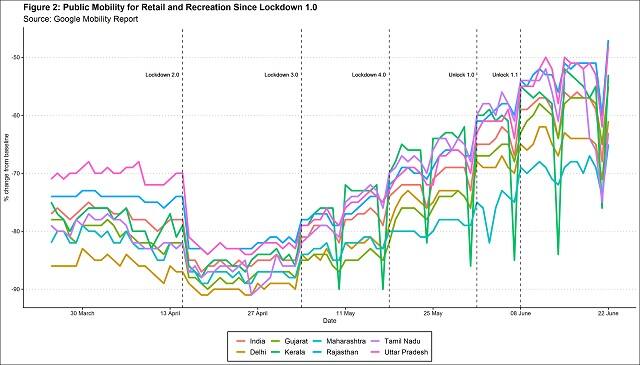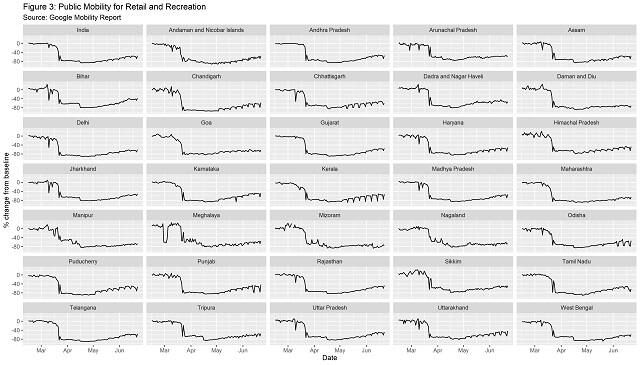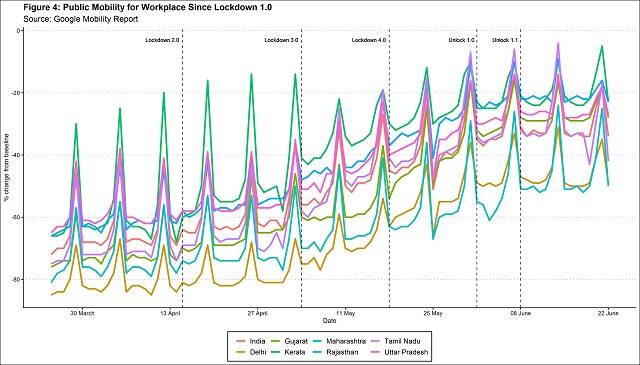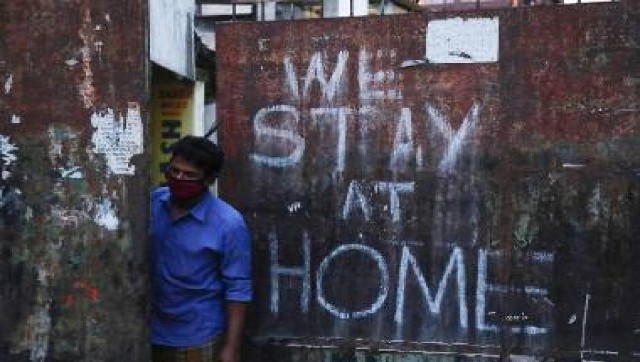Lockdown 5.0, the fifth phase of the nation-wide lockdown, that focused on phased resumption of free movement and economic activity, will come to an end on 30 June. The ‘Unlock’ included among other things, the reopening of shopping malls, markets and religious places of worship. Prime Minister Narendra Modi had emphatically
stated at the CII annual convention, “We will get our growth back.” The government might have had a quick V-shaped recovery in its mind. However, despite the confidence displayed by Modi, our analysis of anonymised GPS location data by Google shows that public movement has not recovered as much as a V-shape recovery would require. In an earlier
piece , we had described the data and discussed some of the advantages and disadvantages of using this data for economic inference. The baseline of this data is taken to be the median value for the corresponding day of the week during the period between 3 January and 6 February. To further build on the previous work, this article will include public mobility data till 22 June, almost three weeks after Unlock 1 relaxations were put in place, to understand whether the public agrees with the sentiment expressed by the prime minister. Using a more disaggregated version of the results, an effort will be made to understand state-level variation in the levels of public movement. Which states have higher mobility levels and which states have seen quicker recovery compared to others? This analysis will focus on two indicators: Retail and recreation, and workplace. Retail and recreation is a key indicator because it captures voluntary movement, as opposed to ’essentials’ like pharmacy, supermarket which are mostly dictated by needs. At the same time, workplace activity will also be examined as a rough indicator of supply and production resuming, as opposed to the demand through retail movement. Geographic variability in retail and recreation movement At the national-level, the trends continue to move on the same path noted previously. The retail and recreation movement has been on the rise, albeit very slowly. Mobility trends for supermarket and pharmacy have significantly increased and are now four percent above the baseline level. Public transport (transit station) also continues to pick up steadily and is now at -37 percent compared to the baseline. Workplace has also continued with its trend of steady increase and is now at -34 percent. Parks continue to remain largely at the same level, now at -49 percent. The following map shows the variability in retail and recreation mobility across states as on 22 June. There is significant variation in the levels of lockdown compliance across states, as values ranging from -50 to -90 show. Jammu and Kashmir data may not be comparable because of connectivity issues in the state and therefore has been dropped from the analysis; Google has not released data for Lakshadweep due to data quality issues. The existing records show that mobility has remained positive in Jammu and Kashmir compared to the baseline level. Despite some variability, the overall mobility remains quite low in all states. [caption id=“attachment_8528761” align=“alignnone” width=“640”] Retail and recreation mobility on 22 June[/caption] What is also interesting to see is how these trends have changed over time across different states. The graph below features the states with the highest number of COVID-19 cases in India, mapped out from 25 March to 22 June. The results show that despite the variation in levels, the direction of the movement of the mobility has largely remained similar across all states. The interesting result is in Kerala, where the sharpest changes in mobility on the weekends can be seen. Other states also have those dips, albeit much smaller ones. [caption id=“attachment_8528781” align=“alignnone” width=“640”]
 Public mobility for retail and recreation since the first lockdown[/caption] Maharashtra, with the highest number of confirmed COVID-19 cases, has also shown a very small increase. There could be two reasons for this. First, due to the very large number of daily cases, there is possibly a widespread fear among people. Second, the state government of Maharashtra could be implementing social distancing measures more strictly as compared to other states. Retail and recreation has increased swiftest in Bihar, at -38 percent as compared to the baseline. For most other states, the curve is very similar to the national curve. However, in North East states like Manipur, Meghalaya, Mizoram, and Nagaland, there is a very tiny increase — almost negligible. For Mizoram, it has actually further decreased from the pre-unlock phase. In the North East, Assam has the highest increase. [caption id=“attachment_8528801” align=“alignnone” width=“640”]
Public mobility for retail and recreation since the first lockdown[/caption] Maharashtra, with the highest number of confirmed COVID-19 cases, has also shown a very small increase. There could be two reasons for this. First, due to the very large number of daily cases, there is possibly a widespread fear among people. Second, the state government of Maharashtra could be implementing social distancing measures more strictly as compared to other states. Retail and recreation has increased swiftest in Bihar, at -38 percent as compared to the baseline. For most other states, the curve is very similar to the national curve. However, in North East states like Manipur, Meghalaya, Mizoram, and Nagaland, there is a very tiny increase — almost negligible. For Mizoram, it has actually further decreased from the pre-unlock phase. In the North East, Assam has the highest increase. [caption id=“attachment_8528801” align=“alignnone” width=“640”] Public mobility for retail and recreation[/caption] Workplace Activity The recovery in mobility for workplace activity has been much quicker than retail and recreation recovery. Again, most states have followed an almost similar trajectory of increase in workplace mobility across time. However, there remains a variation in the overall level of mobility changes. The graph below depicts workplace mobility across different states that had the highest number of COVID-19 cases. The increasing numbers in workplace activity capture the fact that production and supply have already recovered by around 60 to 70 percent. At the current rate, we can expect it to have fully recovered by the end of next week. So even though production has already started recovering at a quick pace, because retail activity is taking time to pick up, the demand in the economy may remain low for much longer than expected. [caption id=“attachment_8528821” align=“alignnone” width=“640”]
Public mobility for retail and recreation[/caption] Workplace Activity The recovery in mobility for workplace activity has been much quicker than retail and recreation recovery. Again, most states have followed an almost similar trajectory of increase in workplace mobility across time. However, there remains a variation in the overall level of mobility changes. The graph below depicts workplace mobility across different states that had the highest number of COVID-19 cases. The increasing numbers in workplace activity capture the fact that production and supply have already recovered by around 60 to 70 percent. At the current rate, we can expect it to have fully recovered by the end of next week. So even though production has already started recovering at a quick pace, because retail activity is taking time to pick up, the demand in the economy may remain low for much longer than expected. [caption id=“attachment_8528821” align=“alignnone” width=“640”] Public mobility for workplaces since the first lockdown[/caption] Looking ahead This analysis shows that public mobility does not immediately pick up even after dramatic relaxations. Even though workplace activity has seen significant increases, economic activity can only recover if people are going out and buying products. The demand is what generates income and boosts the economy. Keeping that in mind, the faith Modi put in a quick recovery may not be shared by the economy unless more efforts are taken to boost the aggregate demand in the economy. Introducing movement relaxations and instilling confidence will need to be supported with “maximum governance” with greater stimulus as this article
points out. Disclaimer: We are, in no way, implying or encouraging readers to step out of their homes or engage in recreational activities. This article is only meant to inform policy-making by knowing what to expect in terms of economic recovery as and when the threat of virus subsides. Ishaan Bansal is a student of Economics at Ashoka University; he is a research intern at Centre for Economic Data and Analysis (CEDA). Fahad Hasin is a student of Political Science at Ashoka University.
Public mobility for workplaces since the first lockdown[/caption] Looking ahead This analysis shows that public mobility does not immediately pick up even after dramatic relaxations. Even though workplace activity has seen significant increases, economic activity can only recover if people are going out and buying products. The demand is what generates income and boosts the economy. Keeping that in mind, the faith Modi put in a quick recovery may not be shared by the economy unless more efforts are taken to boost the aggregate demand in the economy. Introducing movement relaxations and instilling confidence will need to be supported with “maximum governance” with greater stimulus as this article
points out. Disclaimer: We are, in no way, implying or encouraging readers to step out of their homes or engage in recreational activities. This article is only meant to inform policy-making by knowing what to expect in terms of economic recovery as and when the threat of virus subsides. Ishaan Bansal is a student of Economics at Ashoka University; he is a research intern at Centre for Economic Data and Analysis (CEDA). Fahad Hasin is a student of Political Science at Ashoka University.
Even though workplace activity has seen significant increases since the first COVID-19 lockdown, economic activity can only recover if people are going out and buying products
Advertisement
End of Article


)

)
)
)
)
)
)
)
)



